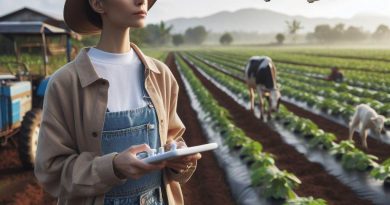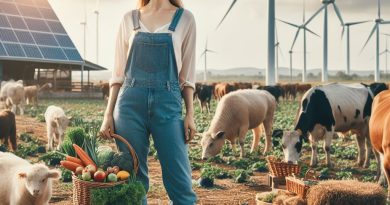Precision Planting: The Tech Evolution
Last Updated on February 23, 2024
Introduction
Precision planting is a critical aspect of modern agriculture.
It involves utilizing advanced technology and techniques to ensure maximum yields and efficiency in crop production.
Technological advancements have greatly transformed precision planting methods.
From simple hand planting to more sophisticated practices, technology has brought about significant improvements.
One of the most notable advancements is the use of GPS systems in precision planting.
GPS technology enables farmers to accurately identify and map their fields.
This information is crucial for determining the optimum planting patterns and ensuring uniform seed distribution.
Another technological breakthrough in precision planting is the development of automated planters.
These machines are equipped with advanced sensors and control systems that precisely place seeds at optimal depths and spacing.
This not only saves time and labor but also improves the overall germination and growth of crops.
Furthermore, the introduction of variable rate technology (VRT) has revolutionized precision planting.
VRT allows farmers to vary the seed population and fertilizer application rates according to the specific requirements of different areas within a field.
This ensures optimal plant growth and resource utilization, resulting in higher yields and reduced environmental impact.
In fact, precision planting in modern agriculture is of paramount importance.
Through advancements in technology, farmers can now achieve higher yields, improved crop quality, and enhanced overall productivity.
Continued innovation in precision planting will play a significant role in meeting the challenges of feeding a growing global population while minimizing resource waste.
Early Methods of Planting
Traditional farming practices
- Farmers relied on manual labor and rudimentary tools to plant crops.
- Seeds were typically sown by hand, using basic techniques passed down from generation to generation.
- Accuracy and uniformity in planting were difficult to achieve, resulting in uneven crop growth.
Challenges and limitations in planting techniques
- Inconsistent seed spacing led to competition among plants for resources, affecting overall yield.
- Poor seed-to-soil contact hindered germination and reduced the success rate of seedlings.
- Limited control over seed depth and placement made it challenging to optimize growing conditions.
- Manual labor required more time and effort, hindering overall efficiency in planting operations.
Need for precision and accuracy in planting
- To meet the growing demand for food, farmers started seeking more efficient planting techniques.
- Precision planting became crucial for maximizing crop yield and minimizing resource wastage.
The evolution of planting techniques from traditional practices to precision planting has revolutionized agriculture.
By addressing the challenges and limitations of early methods, precision planting has become essential for modern farming.
Thanks to advancements in technology, farmers can now achieve greater accuracy, uniformity, and efficiency in planting.
Precision planting not only maximizes crop yield but also minimizes resource usage, benefiting both farmers and the environment.
As technology continues to advance, we can expect further improvements in precision planting, driving the future of agriculture.
Read: Robotics in Organic Farming: Insights
Emergence of Precision Planting Technology
Introduction of early precision planting equipment
- In the early stages, precision planting equipment was introduced to revolutionize farming practices.
- These tools allowed farmers to plant seeds with greater accuracy and efficiency.
- The introduction of precision planting equipment marked a significant shift in agricultural technology.
Initial benefits and improvements
- Farmers quickly noticed the benefits of precision planting technology.
- The equipment enabled them to achieve consistent seed spacing, resulting in higher crop yields.
- Precision planting technology also reduced seed waste and improved overall seedling emergence.
- This led to cost savings for farmers and increased profitability in their operations.
- As farmers continued to use precision planting equipment, they discovered other areas for improvement.
- Companies started developing advanced features and functionalities to meet the evolving needs of farmers.
Growing popularity among farmers
- The success and benefits of precision planting technology quickly spread among farmers.
- Many farmers began adopting this technology to optimize their planting processes.
- The precision planting equipment became an essential tool for modern-day farmers.
- The popularity of precision planting technology grew as word spread about its positive impact on crop production.
- Farmers realized the importance of accurate and efficient planting to maximize their yields.
- The ability to precisely plant seeds allowed farmers to achieve uniform crop emergence and maturity.
- With precision planting technology, farmers gained more control over their planting operations.
- They could tailor their practices to specific crop varieties and environmental conditions.
- Precision planting technology also played a crucial role in sustainable farming practices.
- By minimizing seed waste and optimizing seedling emergence, farmers reduced their environmental footprint.
- As precision planting technology continued to advance, more farmers recognized its long-term value.
- The technology became an investment that paid off in terms of increased yields and improved productivity.
- Today, precision planting is widely adopted and has become a standard practice in modern agriculture.
- Farmers understand the importance of embracing technology to stay competitive and meet the demands of the industry.
- Precision planting technology continues to evolve, with ongoing research and development to enhance its capabilities.
In short, the emergence of precision planting technology revolutionized farming practices.
Its introduction brought about significant benefits and improvements in crop production.
With its growing popularity among farmers, precision planting technology has become an essential tool in modern agriculture.
By embracing this technology, farmers can achieve accurate and efficient planting, resulting in higher yields and environmental sustainability.
Precision planting technology is a testament to the continuous evolution of agricultural practices to meet the demands of a changing world.
Read: Agri Drones: Beyond Just Surveillance
Evolution of Precision Planting Technology
Introduction of GPS technology
GPS technology revolutionized precision planting by providing accurate positioning data for farmers.
This technology uses signals from satellites to determine exact locations on the field.
- GPS allows for precise navigation: Farmers can now navigate their equipment efficiently in the field, reducing overlaps and optimizing seed and fertilizer distribution.
- Improved accuracy in planting: With GPS, farmers can precisely line up rows and maintain consistent spacing between plants, resulting in better crop yields.
Development of sophisticated seeders and planters
Advancements in seeders and planters have greatly contributed to the evolution of precision planting technology.
- Variable-rate technology: Modern seeders can adjust the amount of seed planted in real-time, based on specific soil conditions, topography, and historical crop data.
- Multiple seed placement options: Seeders now offer various options for seed placement, such as depth control, singulation, and furrow closing, ensuring optimal growth conditions for each seed.
Integration of data-driven decision-making tools
Data-driven decision-making tools have become crucial in precision planting, enabling farmers to make informed choices based on real-time data.
- Yield mapping: Farmers can use yield mapping to identify areas of the field with varying production levels, allowing for targeted adjustments to improve overall efficiency.
- Soil analysis: Data analysis tools provide insights into soil fertility, moisture levels, and nutrient requirements, enabling farmers to customize their planting strategies accordingly.
- Integration with weather forecasts: By integrating weather forecasts into precision planting systems, farmers can optimize planting schedules, reducing the risk of adverse weather conditions.
Advanced seed monitoring and mapping systems
Seed monitoring and mapping systems have significantly enhanced precision planting practices.
- Real-time monitoring: Advanced sensors on planters can monitor seed singulation, spacing, and depth, ensuring accurate seed placement.
- Mapping and documentation: These systems generate detailed maps and reports, allowing farmers to analyze planting performance and make necessary adjustments for future seasons.
- Early detection of issues: Seed monitoring systems can detect issues like doubled-up or skipped seeds, allowing farmers to take immediate corrective actions.
In essence, the evolution of precision planting technology has seen significant advancements in GPS positioning, sophisticated seeders, data-driven decision-making tools, and advanced seed monitoring systems.
These advancements have revolutionized farming practices, enabling farmers to achieve higher yields, conserve resources, and make more informed decisions for sustainable agriculture.
As technology continues to evolve, precision planting will continue to play a vital role in optimizing crop production and ensuring food security.
Read: Harvest Tech: Robotic Arms in Use

Benefits of Precision Planting
Increased crop yield and productivity
Precision planting technology has revolutionized the agricultural industry, offering numerous benefits that have greatly enhanced crop yield and productivity.
By utilizing advanced planting techniques and equipment, farmers are able to achieve higher yields than ever before.
The precise placement of seeds ensures optimal spacing and depth, leading to improved germination rates and more uniform plant growth.
As a result, farmers can expect higher crop yields, maximizing their profits and meeting the increasing demand for food in a growing global population.
Efficient use of resources such as seeds, fertilizers, and water
Precision planting also enables farmers to make more efficient use of valuable resources, including seeds, fertilizers, and water.
With this technology, farmers can accurately determine the optimal amount of seeds to plant, reducing wastage and saving costs.
Additionally, by precisely placing seeds and applying fertilizers at the right depth and proximity to the plants, nutrient absorption is maximized.
This eliminates unnecessary wastage, resulting in improved plant health and overall crop productivity.
Water is another crucial resource that can be conserved through precision planting.
By optimizing irrigation systems based on plant-specific needs and soil moisture levels, farmers can avoid overwatering or underwatering their crops, leading to better water utilization and reduced environmental impact.
Improved crop uniformity and quality
The precision achieved through precision planting technology greatly enhances crop uniformity and overall quality.
By ensuring accurate spacing and depth, plants receive equal access to sunlight, nutrients, and water.
This promotes consistent growth and minimizes competition among plants, leading to a more uniform crop.
Uniform crops are not only visually appealing but also easier to manage during harvesting and storage processes.
Additionally, it allows for more efficient application of pesticides and herbicides, targeting specific areas without harming neighboring plants.
Ultimately, improved crop uniformity leads to higher market value and customer satisfaction.
Reduced environmental impact
Precision planting techniques have significant environmental benefits, reducing the overall impact of agriculture on the environment.
By optimizing resource utilization, farmers can minimize the use of fertilizers, pesticides, and water, reducing the potential for groundwater contamination and environmental pollution.
Precision planting also enables farmers to implement conservation practices more effectively.
By reducing soil erosion, enhancing nutrient management, and supporting biodiversity, precision planting helps maintain soil health and protects natural ecosystems.
Furthermore, precision planting technology enables farmers to adopt sustainable practices such as cover cropping and precision nutrient application.
These practices help sequester carbon, improve soil fertility, and reduce greenhouse gas emissions, contributing to a more sustainable and resilient agricultural system.
In review, precision planting offers a range of benefits that significantly improve agricultural practices.
By increasing crop yield and productivity, efficiently utilizing resources, improving crop uniformity and quality, and reducing environmental impact, precision planting technology plays a critical role in sustainable and profitable farming.
Embracing this technological evolution can pave the way for a more efficient, resilient, and environmentally friendly agricultural industry.
Read: Yield Boosting: Robotics in Action
Challenges and Considerations
While precision planting technology offers a wide range of benefits, there are certain challenges and considerations that farmers need to address:
Initial investment and cost of precision planting technology.
- Precision planting technology requires a significant initial investment, including the purchase of equipment and software.
- The cost of precision planting technology can be a deterrent for some farmers, especially those with limited financial resources.
- However, it is important to consider the long-term benefits and potential return on investment that precision planting can provide.
Need for proper training and knowledge for effective utilization.
- Precision planting technology is complex and requires farmers to have a thorough understanding of its operation.
- Farmers need to undergo proper training to ensure they can effectively utilize the technology and optimize its benefits.
- Without adequate knowledge and training, farmers may not be able to fully leverage the capabilities of precision planting technology.
Integration with other farming practices and systems.
- Precision planting technology needs to be integrated with other farming practices and systems to maximize its effectiveness.
- Farmers should consider how precision planting will fit into their existing workflow and overall farm management strategy.
- Integration may require additional investments in equipment or modifications to existing systems, which should be carefully planned.
- Proper coordination between precision planting technology and other practices is crucial to avoid conflicts and ensure smooth operations.
- Farmers may need to seek guidance from agronomists or agricultural experts to effectively integrate precision planting technology.
Overall, while precision planting technology offers numerous benefits, farmers must carefully consider the challenges and requirements for its successful implementation.
By weighing the initial investment, acquiring the necessary training and knowledge, and planning for seamless integration, farmers can overcome these challenges and fully utilize the potential of precision planting technology.
Furthermore, as the technology continues to evolve and improve, the challenges associated with its adoption are likely to diminish, making precision planting an even more attractive option for modern farmers.
Future Trends and Innovations
Integration of artificial intelligence and machine learning
- Artificial intelligence and machine learning will play a crucial role in the future of precision planting.
- These technologies will enable farms to leverage large amounts of data for more accurate planting decisions.
- AI algorithms can analyze data on soil health, weather patterns, and crop performance to optimize planting strategies.
- Predictive models can be created to anticipate crop yields and plant growth based on historical data and current conditions.
- Machine learning can continuously improve planting techniques by learning from past experiences and adjusting planting parameters accordingly.
Adoption of autonomous planting systems
- The future of precision planting lies in the adoption of autonomous systems that can handle planting operations without human intervention.
- Autonomous planting machines equipped with GPS and sensors can precisely plant seeds with optimal spacing and depth.
- These systems can achieve higher planting accuracy, reduce human error, and increase planting efficiency.
- Farmers can remotely monitor and control the planting process, allowing them to focus on other crucial farm management tasks.
- The use of autonomous planting systems can also lead to cost savings by reducing labor requirements and enhancing resource utilization.
Potential impact of robotics and drones in precision planting
- Robotics and drones have the potential to revolutionize precision planting by performing tasks that are challenging for humans or traditional machinery.
- Drones equipped with advanced imaging technology can provide real-time insights into crop health, allowing farmers to identify and address issues promptly.
- Robotic arms can be used for precise seed placement and application of fertilizers and pesticides, minimizing waste and ensuring targeted delivery.
- These technologies can significantly reduce manual labor and increase planting accuracy, resulting in higher crop yields and resource efficiency.
- Robotics and drones also enable farmers to survey large areas of land quickly and efficiently, providing valuable data for decision-making.
The integration of artificial intelligence and machine learning, adoption of autonomous planting systems, and the potential impact of robotics and drones signify the future of precision planting.
These advancements will enable farmers to make data-driven planting decisions, improve planting accuracy, and optimize resource utilization.
By harnessing the power of AI and machine learning, farms can leverage vast amounts of data to maximize crop yields and ensure sustainable farming practices.
The adoption of autonomous systems will further enhance planting efficiency and reduce human error.
Moreover, robotics and drones offer promising capabilities in crop health monitoring, precise seed placement, and efficient land surveying.
With these future trends and innovations, precision planting is set to revolutionize the agricultural industry, enabling farmers to achieve higher productivity, profitability, and sustainability.
Conclusion
Precision planting technology has undergone a rapid evolution, revolutionizing farming practices.
It is crucial for farmers to adopt precision planting techniques to ensure future farming sustainability.
Encouragement is extended to farmers to actively explore and embrace innovative solutions for precision planting.
These advancements not only enhance productivity but also contribute to environmental conservation and resource optimization.
Embracing precision planting techniques is not merely an option but a necessity in the face of evolving agricultural challenges.
By harnessing the power of technology and innovation, farmers can achieve higher yields, reduce input costs, and minimize environmental impact.
The journey towards precision planting may present challenges, but the rewards are significant.
As we move forward, let us continue to push the boundaries of agricultural innovation and embrace the transformative potential of precision planting technology.
Together, we can build a more sustainable and resilient future for farming.


